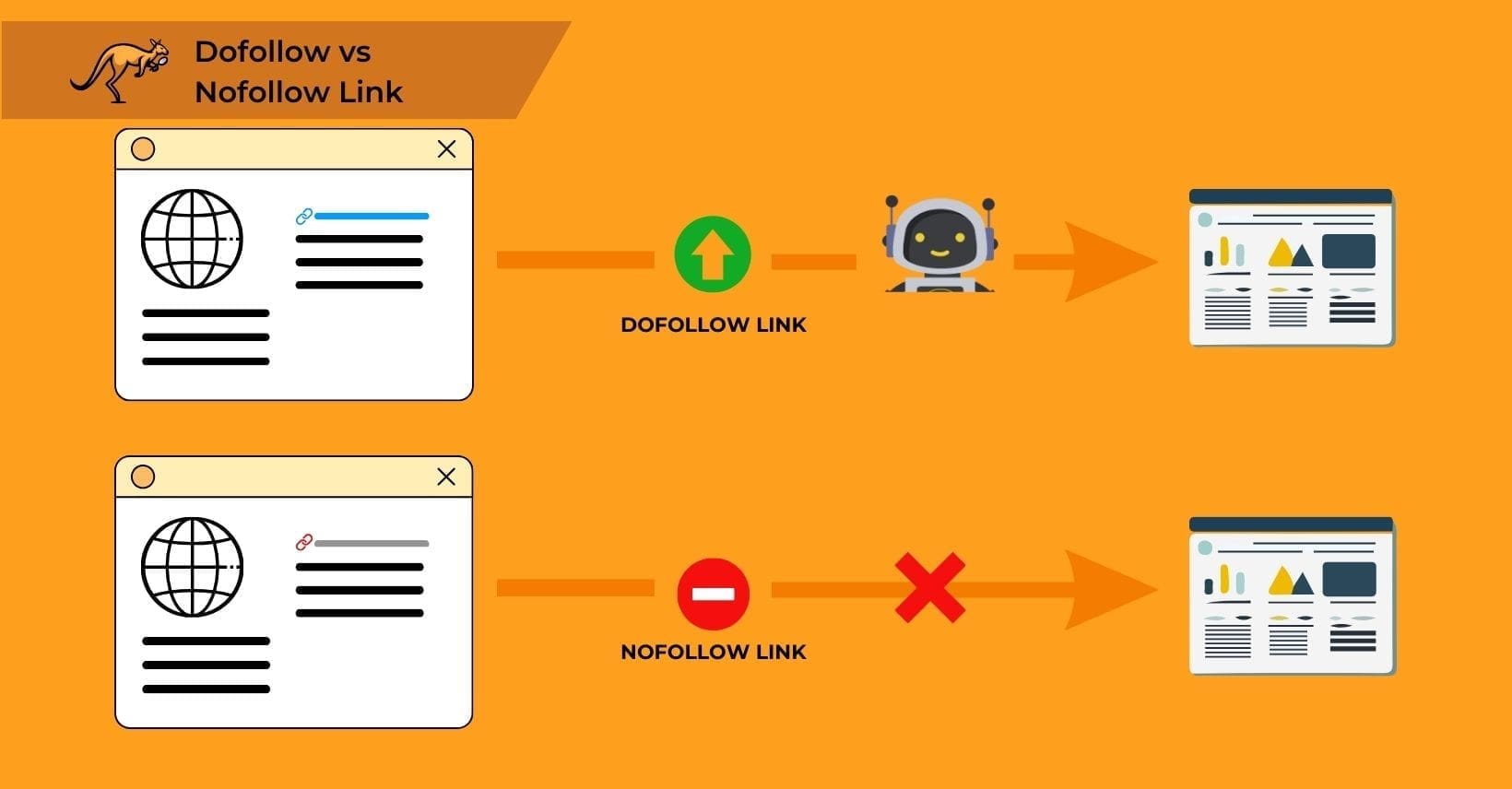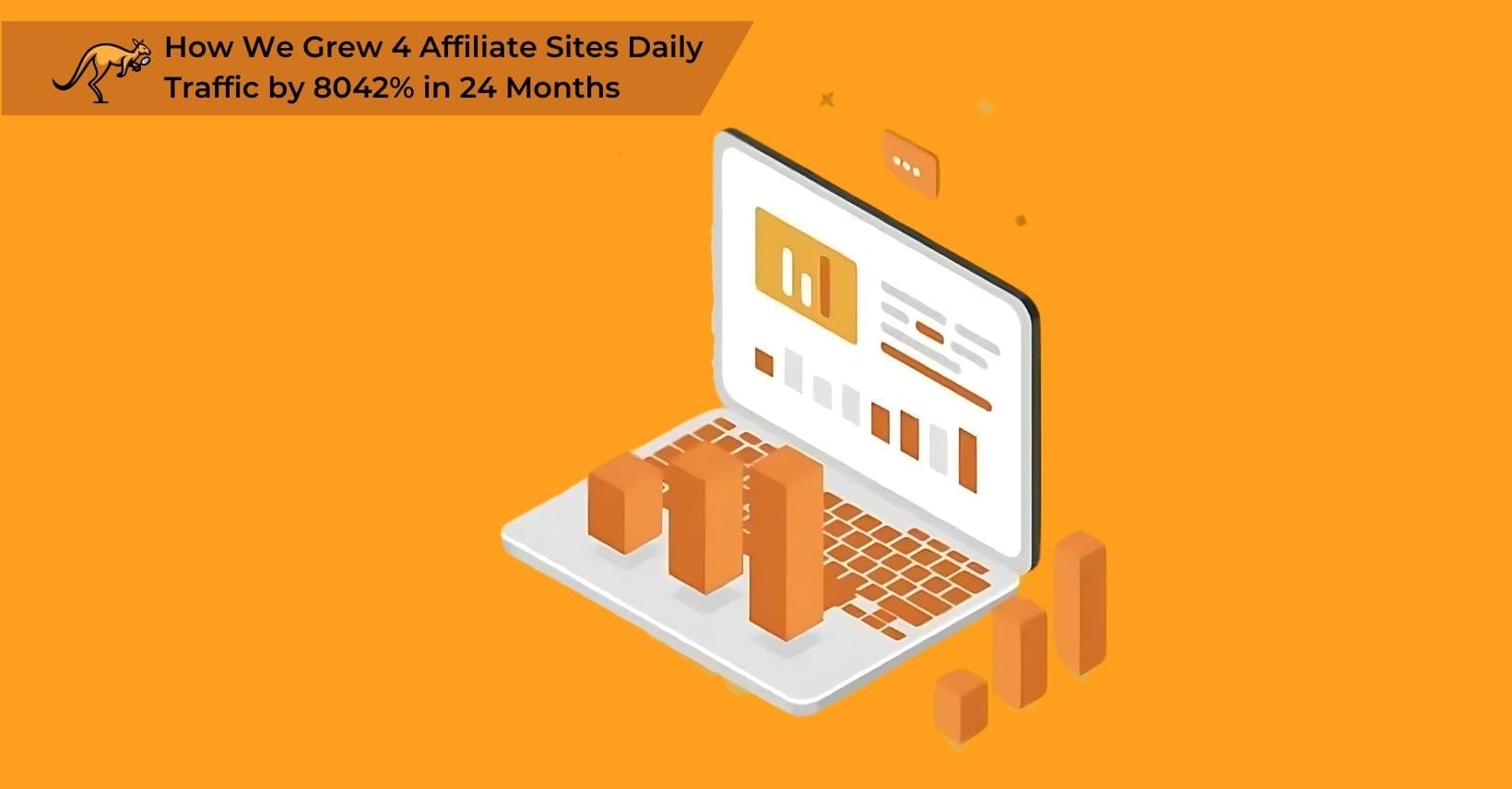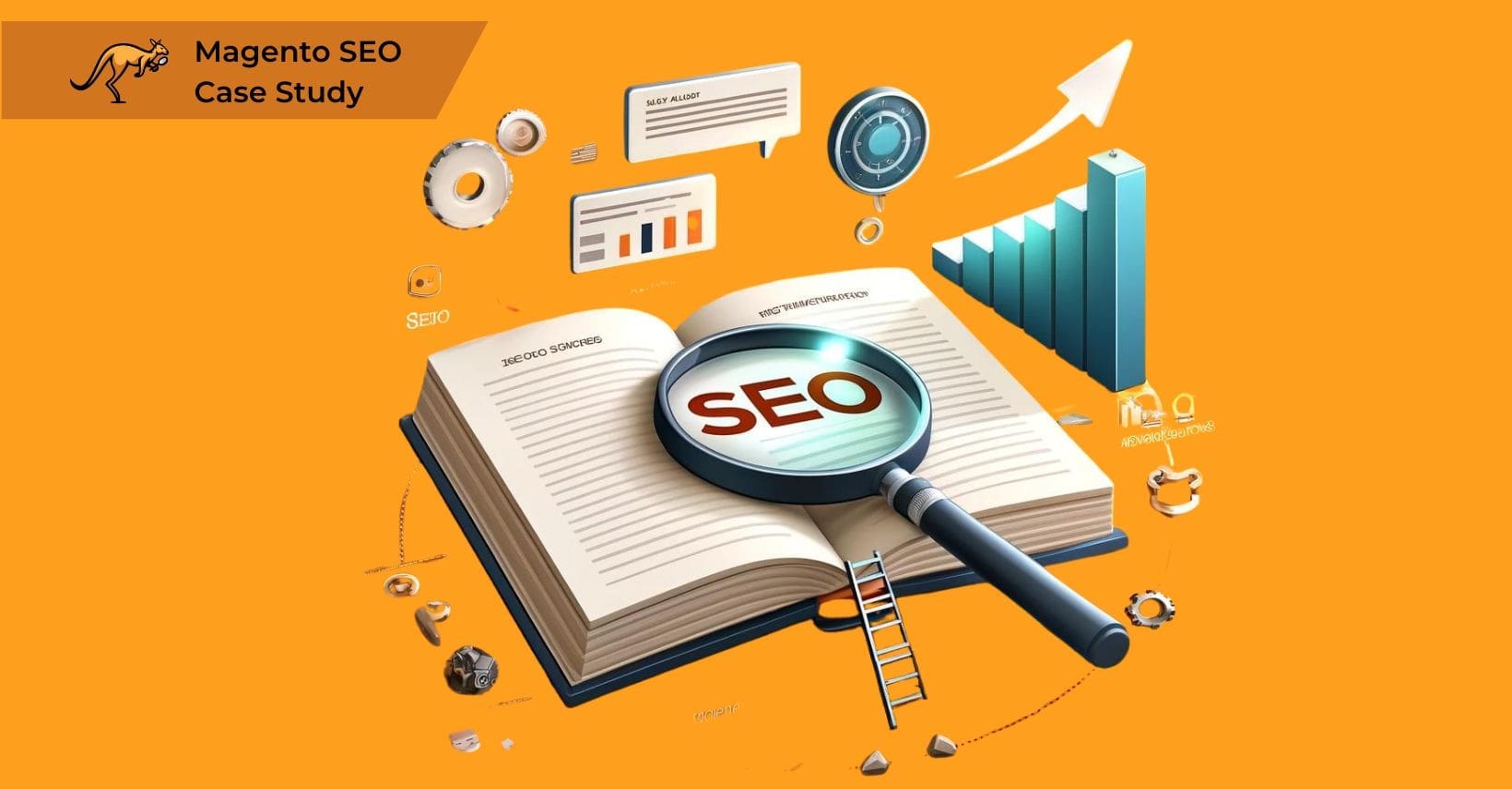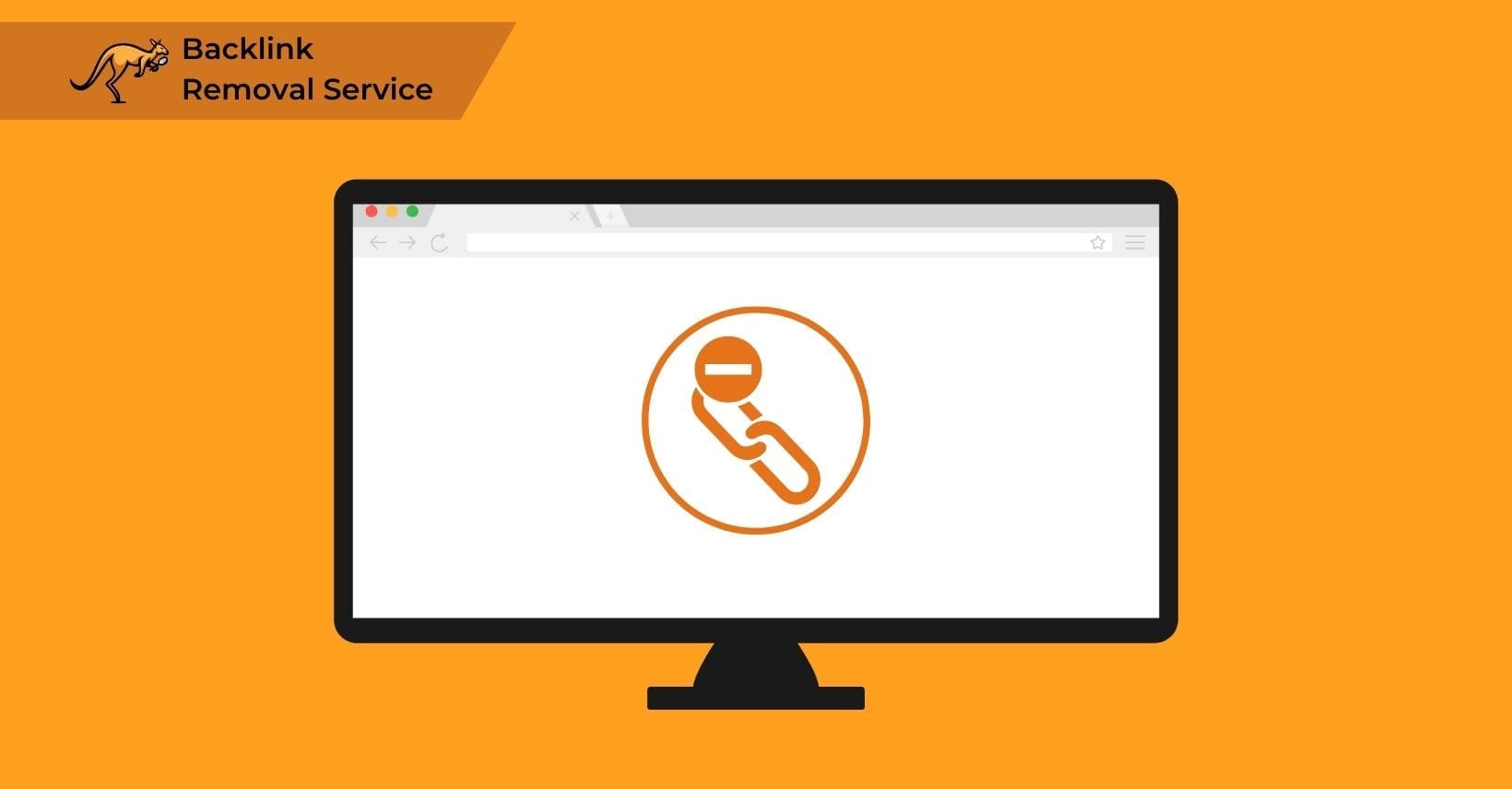Dofollow and nofollow links are essential components of SEO. They are crucial for anyone to understand, regardless of their expertise in the field.
At first glance, it might seem that all links are the same. Still, a key distinction between them plays a pivotal role in search engine optimization and building a website’s link profile.
So, what exactly distinguishes these two types of links?
As we explore how dofollow links can boost a site’s visibility and how nofollow links protect against spam, it becomes clear why both are fundamental in managing a site’s outreach and credibility.
Let’s examine the definitions and roles of dofollow and nofollow links.
What are Dofollow Links and Nofollow Links?
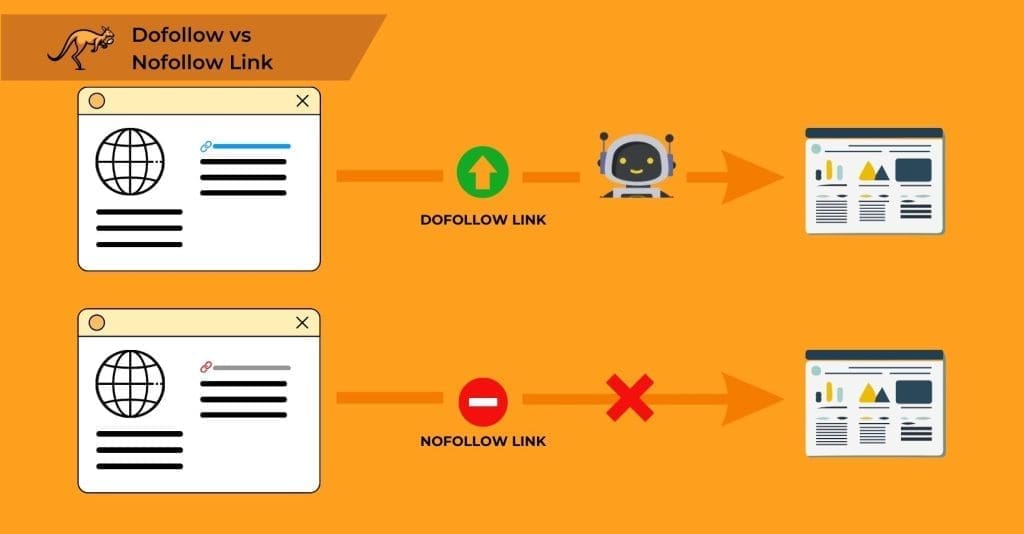
A dofollow link represents a standard internet hyperlink without special attributes that passes authority, also known as “link juice,” from one website to another when search engines crawl the page, which helps boost the linked site’s search engine rankings.
On the other hand, a nofollow link contains the rel=”nofollow” HTML attribute that instructs search engines not to transfer authority or “link juice” to the target site, which means search engines don’t consider nofollow links when calculating rankings based on link profiles.
Dofollow links directly support a website’s SEO efforts, unlike nofollow links, which serve different purposes. Although nofollow links don’t directly boost SEO, they still hold value for different strategic uses.
Moving from understanding link types, it’s natural to wonder about the workings behind dofollow links and how they contribute to a website’s search engine ranking.
How Do Dofollow Links Work?
Dofollow links provide significant benefits for SEO by transferring ranking power from one site to another, which increases your website’s authority, improves search engine visibility, and helps your pages rank higher for targeted keywords when acquired from relevant, high-quality sources.
Dofollow links transfer authority or “link juice” by acting as votes of confidence; when a high-authority website links to another site with a dofollow link, search engines interpret this connection as an endorsement, which passes PageRank and enhances the linked site’s authority in search algorithms.
This boost can elevate your site’s position on search engine results pages if the link is relevant and comes from a reputable source. High-quality dofollow backlinks are valuable, making them a coveted asset in SEO strategies.
They signal to search engines that your content is valuable enough to be recommended by others, reinforcing your site’s relevance and authority. As your collection of these endorsements grows, so does your potential to attract more visitors from your target audience.
On the flip side, there’s another type of link whose influence on SEO works differently. Let’s explore how nofollow links function.
How Do Nofollow Links Work?
Nofollow links, unlike their dofollow counterparts, do not convey PageRank or link authority because they indicate a website’s choice to link to another without endorsing it.
While nofollow links allow users to navigate between websites, they signal search engines to disregard any implied trust or endorsement that dofollow links typically provide. Therefore, their influence on SEO is minimal, if any.
These links are particularly useful for site owners who prefer not to vouch for or boost the SEO of sites they link to, especially when their familiarity with the linked sites is limited.
Often, nofollow tags are applied in situations where a site references another for contextual purposes rather than full endorsement.
On platforms like social media, this strategy prevents users from exploiting the site’s authority, with strict limits often placed on the use of dofollow links.
While the benefits of nofollow links are clear in certain contexts, it raises the question of their overall value in web management. Are nofollow links a bad thing to have?
This inquiry leads us to consider their roles and effects in a broader linking strategy.
Are Nofollow Links A Bad Thing To Have?
It is easy to assume that nofollow links are bad, given that the nofollow tag stops the link from impacting SEO.
Nofollow links offer valuable benefits despite not passing SEO authority, including driving referral traffic to your website, diversifying your backlink profile to appear natural to search engines, and protecting your site from potential penalties associated with low-quality outbound links.
As the link creator, a nofollow link can stop your links to other websites from reflecting badly on you.
A site that keeps giving link equity to scam sites or other low-quality websites will usually have its own rankings reduced, too, since it is endorsing very poor-quality platforms.
This also means that articles can reference other content directly without giving authority to those websites.
This can be useful if you want to link something produced by a competitor or a spam site but do not want to contribute to that platform’s SEO in the process.
As a link recipient, it is good to have a healthy mixture of dofollow and nofollow links. Not only does this make your site feel more legitimate, but it has a direct effect on your search engine rankings.
Search platforms will notice if literally every link you receive is dofollow, and this can come across as your site paying for a constant stream of dofollow links.
By retaining nofollow links in your link profile, you are showing that you have an authentic set of backlinks gained in multiple different ways.
Their authority-blocking tag can also work in reverse sometimes.
Nofollow links from spam websites are much less likely to damage your SEO compared to getting a lot of regular dofollow backlinks from questionable or spammy websites.
Nofollow Links From Spam-Filled Websites
Nofollow links often get a bad reputation because they don’t affect SEO rankings. Still, they play a crucial role for the one who links and receives the link.
Creating a nofollow link prevents your site from being negatively associated with low-quality or spammy sites, which could harm your SEO status.
This is especially handy when referencing a competitor or a dubious website without boosting its SEO strength. Similarly, having a blend of dofollow and nofollow links as a recipient adds legitimacy to your website.
Search engines might suspect foul play if every backlink you have is a dofollow, possibly indicating manipulation of links.
Including nofollow links demonstrates a varied and authentic backlink profile.
They can also protect your site from being linked to spam-heavy websites, which might otherwise lower your SEO quality if they were all dofollow links.
Maintaining nofollow links from websites filled with spam can be a strategic move in safeguarding your site’s reputation.
How Can You Identify Nofollow Links?
Nofollow links are identified by a specific tag in a website’s HTML. The link format remains consistent in an About page or a forum post because the tag must connect directly to the link’s HTML to function.
For instance, a typical dofollow link appears as:
For example, a typical dofollow link uses the standard HTML anchor tag without any rel attributes, appearing in code as:
<a href=”(websiteaddress.com)”>WebsiteName</a>
Meanwhile, a nofollow link in the exact same context would be:
<a href=”(websiteaddress.com)” rel=”nofollow”>WebsiteName</a>
The rel=”nofollow” attribute serves as an HTML directive that tells search engines not to follow the link or pass authority through it, making it simple to convert dofollow links to nofollow by adding this single tag to the anchor element, which can be quickly implemented if you have access to edit your website’s code.
You can check if a link is dofollow or nofollow by using your browser’s Inspect Element feature to examine the HTML code or by employing specialized SEO tools such as Ahrefs, SEMrush, or Moz to analyze your backlink profile, which will identify the attribute status of each link pointing to your website.
Understanding these distinctions prepares you to explore how these different links affect web traffic and search engine rankings.
The Differences Between Dofollow and Nofollow Links
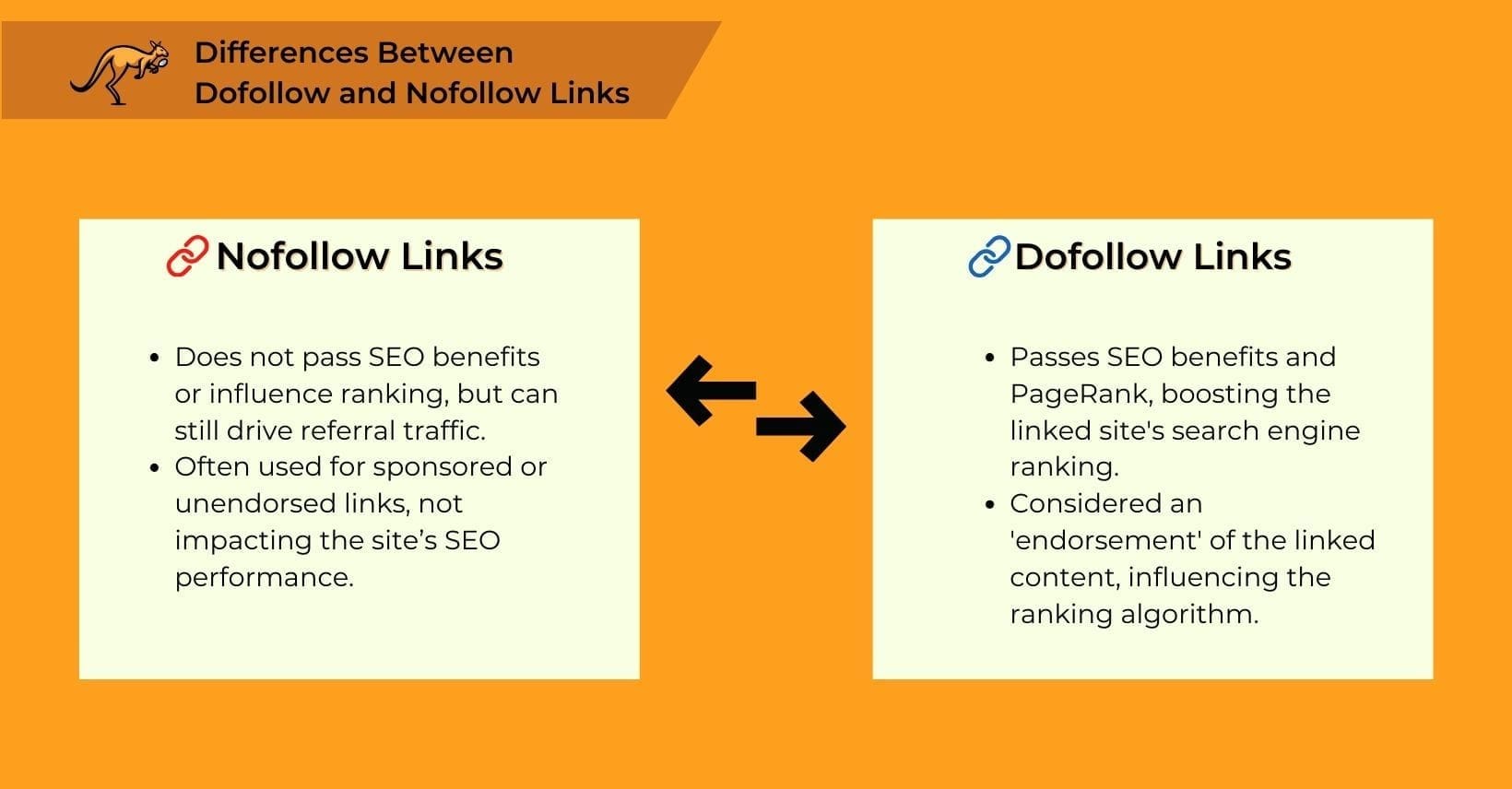
The differences between nofollow and dofollow backlinks are clear when you examine their roles in SEO. Dofollow backlinks transfer PageRank authority from one website to another, influencing search engine rankings, whereas nofollow backlinks only generate referral traffic without affecting SEO.
- Dofollow links pass PageRank authority to other websites through that particular link, which can impact search engine rankings. Nofollow links allow referral traffic but do not contribute to SEO or individual ranking factors.
- Dofollow links count as an endorsement for a web page in the eyes of search engines. Nofollow backlinks reference another web page without endorsing it.
- Dofollow links are used as part of the ranking algorithm in search engine results pages, meaning that they have an impact on how the target sites will rank. Nofollow links can be changed, deleted, or repurposed without having any significant SEO impact.
- Dofollow external links rely on relevancy as part of their SEO impacts, meaning that relevant inbound and outbound links provide more link juice and SEO boosts. Since nofollow links do not impact SEO, they can be irrelevant and will not necessarily cause any problems with your SEO.
- Dofollow backlinks can be valuable, especially if they come from high-quality sites. Nofollow links can also be valuable, but to a much lower extent, and are not usually as hard to secure.
- Nofollow links are often used as sponsored links since nofollow-sponsored links have their own special “sponsored” tag. Dofollow links are not usually meant to be sponsored since these count as paid links, which is black-hat and against the rules of most search engines.
- Website owners can create dofollow links by simply entering a link into their code or site builder. Nofollow links may require an extra step or two to set up.
- Nofollow links are built to let traffic travel between sites, often using descriptive anchor text in valuable content that helps users understand what they are clicking on. Dofollow links are often used as an SEO feature and are, therefore, usually optimized to give the best SEO results possible.
Capturing High Quality Dofollow Backlinks
Focusing on SEO, it’s essential to recognize the distinct role of dofollow versus nofollow links in transferring link juice. While nofollow links, marked by the nofollow attribute, contribute less to SEO as they don’t pass on PageRank, they are not inherently negative.
However, pursuing high-quality dofollow backlinks is vital because these links transfer PageRank, enhancing a site’s search ranking more effectively.
As you consider strengthening your website’s SEO through these valuable links, it’s also important to think about how to reach out and build these connections effectively.
Reach Out
One effective way to gain more backlinks is to publish content offering value and actively request links from related websites.
This strategy often proves successful, especially if the targeted sites share a common theme and see the benefit in linking to resources their audience finds beneficial.
It’s helpful to suggest specific links and anchor texts they could use. However, it’s not always certain they will follow this without adding a nofollow attribute.
However, making an honest proposal that aligns with their content themes can significantly influence their decision to link. Regular content creators, such as blogs that update frequently, are particularly receptive to this approach.
Providing them with pertinent links can inspire them to develop further content, potentially fostering a mutually beneficial collaboration.
In preparing to work together, the next step naturally involves understanding how to collaborate, enhancing the opportunity for shared success effectively.
Collaborate
If reaching out doesn’t yield results, try collaborating instead. Partnering with your audience or other communities to create content can lead to nofollow and dofollow links.
Such joint efforts enhance your backlink profile by involving more websites and communities and increasing the number of valuable links you can collect.
Moreover, collaboration may reduce costs as others contribute by writing articles or small posts that link back to your site. Engaging with online communities is another way to expand your network and build links effectively.
Join Online Communities
Participating actively in online communities can elevate your brand’s visibility and spread your content more widely.
For instance, discussing your blog posts on technical product reviews within forums can attract more visitors and encourage other websites to link to your content.
However, simply posting links on blog sites isn’t effective. These links are often low quality or are marked as nofollow, which can also give the impression that your company is trying too hard to get clicks.
Instead, suppose you genuinely engage with a community. In that case, you can naturally integrate your site and content into the conversation, leading to increased traffic and wider dissemination of your content.
This approach of authentic participation could smoothly transition into how you might consider contributing a guest post to amplify your reach further and share your expertise on a broader platform.
Guest Post
Guest posting, either by writing on other sites or hosting on your own, can effectively direct links to your website.
This activity grants you control over new content that significantly influences your SEO performance. Guest posts generate backlinks and can attract additional links from third parties who find the content valuable, enhancing your search engine visibility.
By choosing the right partners and forming beneficial agreements, guest posting opens doors to new communities and connections with established websites.
For those interested in broadening their digital strategy, further insights and helpful resources are just around the corner.
Other Links
Besides dofollow and nofollow attributes, search engines recognize several other link attributes including UGC (user-generated content) for comments and forum posts, rel=”sponsored” for paid advertisements, and rel=”canonical” for indicating preferred versions of duplicate pages, each serving specific purposes in how search engines interpret link relationships.
These links indicate that the content, such as comments or forum posts, is user-generated rather than intentionally placed by the website’s creator or a content author.
Similarly, the sponsored tag marks links associated with paid advertisements, as mandated by search engines like Google.
While various attributes modify link behavior, the primary concern for most website owners revolves around the choice between dofollow and nofollow links.
Understanding the nuances between these options helps optimize how search engines assess and value different links.
Nofollow Vs Dofollow Links: A Recap
The nofollow vs. dofollow differences are fairly straightforward, but just as a reminder:
- The link page transfers authority in rel=dofollow vs no authority in a nofollow link.
- Inbound links are considered by search engines in rel=dofollow vs. not considered in a nofollow link.
- The linked page is being endorsed with rel=dofollow vs. not endorsed with a nofollow link.
- Google search rankings are influenced by rel=dofollow vs. not influenced by a nofollow link.
In other words, a nofollow link has no search engine impact.
What Else To Know About Dofollow and Nofollow Link Options
Whether it is an inbound or outbound link, the choice between dofollow and nofollow matters. Both nofollow and dofollow links have their uses, but there is no denying that a dofollow link from a good site is always better than a nofollow backlink.
Sometimes it is even a good idea to consider whether you want nofollow and dofollow links within your site – internal links.
These internal links help Google understand a website’s structure, which matters for SEO, but you do not always want crawlers to see every page connected to every other page.
In link building, the choice of a nofollow link and a dofollow link is important. A nofollow link cuts off any SEO potential that the link could have had, which generally means that you will want to prioritize dofollow options over anything else.
For expert advice on navigating Google penalty recovery, go now to access invaluable insights and strategies to restore your website’s search visibility.
A natural link profile should maintain a balanced ratio of dofollow and nofollow links that mimics organic linking patterns, which prevents search engines from flagging your site for manipulative link building practices while still maximizing the SEO benefits from authoritative dofollow links.
